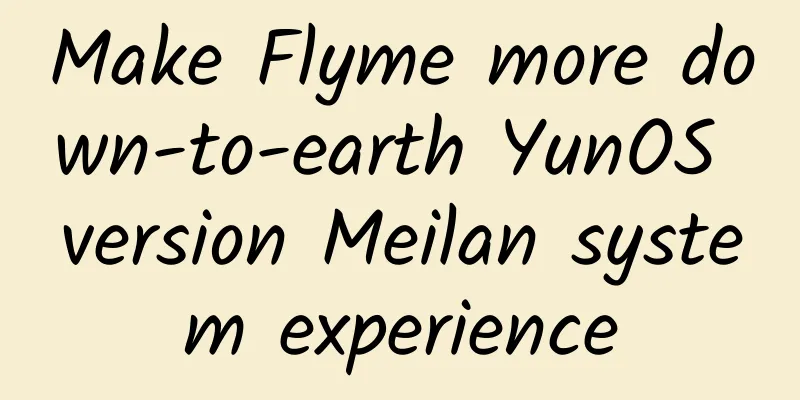Make Flyme more down-to-earth YunOS version Meilan system experience

|
The launch of Meizu Blue allowed Meizu to officially enter the sub-1,000 yuan smartphone market. Soon after, the YunOS version of Meizu Blue was also officially launched recently. We have learned from the previous product unboxing that the YunOS version of Meizu Blue has the "Powered by YunOS" logo on the outer packaging, but all "appearance" elements including product design are no different from the standard version of Meizu Blue. The real change is naturally at the system level of the product. Does YunOS have any impact on performance? The hardware parameters of the YunOS version of Meizu Blue are exactly the same as those of the standard version. In the "Don't Run Around for a Marriage" test, the final score of the YunOS version of Meizu Blue is around 30,000, which is comparable to the score when we tested the standard version of Meizu Blue before. Therefore, we don't need to worry about the performance degradation of the YunOS version of Meizu Blue after changing the underlying system architecture. Are there any changes to Flyme? In fact, we have seen from the previous YunOS version of MX4 that the YunOS version of Meizu mobile phone still retains all the contents of the Flyme operating interface, and this is also retained on the entry-level Meizu Blue. At this stage, YunOS is highly compatible with Android platform software. Combined with the smooth operating experience, users can hardly feel the difference between the YunOS version of Meizu Blue and the standard version of Meizu Blue. If the simple and fresh style of Flyme is a major reason why you choose Meizu Blue, then the YunOS version of Meizu Blue will not disappoint you either. In terms of system features, convenient functions such as gesture wake-up and floating ball also exist on the YunOS version of Meizu, and the newly added simple mode is also not missing. What does YunOS add to Meizu? Slide right on the main interface to enter the life service center of the Meizu Blue system. Just like the previous YunOS version of MX4, this is the most intuitive change that YunOS has brought to the Meizu Blue system. Swiping down in this interface will bring up the search interface. The icon is designed in YunOS's unique card style, which is different from Flyme's icon style. After logging into YunOS, users can customize cards, including adding courier tracking cards and other operations. We all know that YunOS is a product of Alibaba, so we can naturally log in with our Taobao account. Focusing on life services, YunOS can provide quite rich services on Meizu Blue, ranging from entertainment, home to online shopping and basic query tools, covering all kinds of familiar content including Taobao, Tmall and Kuaidi Taxi, and all of these are presented in one interface, without the need for us to download additional APPs and install them separately. As for the operation interface of each category, although the display is well optimized for mobile phones, the details still feel not refined enough. Taking the Taobao lottery and movie projects we tried as an example, the same bottom bar looks more like a Wap site opened on a mobile phone. Although the services provided are relatively complete, the overall usage experience is still somewhat different from that of an independent APP. Summarize: The emergence of "Flyme Powered by YunOS" has given Meizu mobile phone users a new experience and choice. Whether it is the YunOS version of MX4, which was previously positioned as the brand's main model, or the more entry-level YunOS version of Meizu Blue, the overall experience is almost the same as the standard version of the machine, which means that YunOS is now quite complete and mature. Of course, the various life service contents that YunOS brings to Flyme also make Meizu more down-to-earth. From online shopping to various O2O services, in the long run, this can amplify the functions of the mobile phone, making the mobile phone closer to life and easier to use.
As a winner of Toutiao's Qingyun Plan and Baijiahao's Bai+ Plan, the 2019 Baidu Digital Author of the Year, the Baijiahao's Most Popular Author in the Technology Field, the 2019 Sogou Technology and Culture Author, and the 2021 Baijiahao Quarterly Influential Creator, he has won many awards, including the 2013 Sohu Best Industry Media Person, the 2015 China New Media Entrepreneurship Competition Beijing Third Place, the 2015 Guangmang Experience Award, the 2015 China New Media Entrepreneurship Competition Finals Third Place, and the 2018 Baidu Dynamic Annual Powerful Celebrity. |
Recommend
The copy targeting is the same, why is the CTR still lower than others?
The copywriting is obviously very well written, s...
9 lessons to teach you how to quickly increase your attraction and make him fall deeper and deeper in love with you
Broadcaster and host of Communication University ...
New ASO optimization trends you must know for APP promotion in 2017!
In the final analysis, ASO is essentially about sa...
Ruan Yifeng: Introduction to Monte Carlo Method
1. Overview The Monte Carlo method is a calculati...
Ideas + steps + methods, three steps to teach you how to quickly build user portraits?
If you are walking on the street and see a person...
Arctic Impressions丨Legendary Arctic Episode 5
People call the Earth the "blue planet"...
Five rules to start your growth hacking journey
The Origins of Growth Hacking Originated from Sil...
Channel Operation丨If you want to be a promotion expert, you need to combine surprising tactics
There is a saying that "channels are king&qu...
Things about online game advertising | Insights into information flow advertising data
Online game advertising has a special position in...
Air ticket prices are as low as 30 yuan. What are the reasons for the drastic drop in air ticket prices?
Because of the outbreak, many companies in many i...
Smart TVs are popular but not popular, so the interactive mode needs to be solved
The transformation of the home appliance industry...
This documentary is called the animal version of "Game of Thrones"
The story begins on an afternoon with rolling thu...
Can crabs be raised in the desert? Yes, they are coming to your table soon!
Produced by: Science Popularization China Author:...
Yueyang SEO Training: Is it necessary for enterprises to continue to do online promotion?
Nowadays, online marketing PPC bidding ads, SEO, ...
Can you find "crystal" around Chengdu? Experts: It's actually calcite
This winter, many residents and tourists in Cheng...









